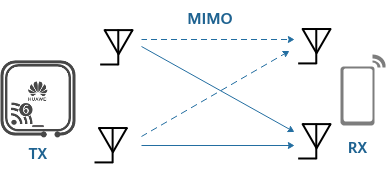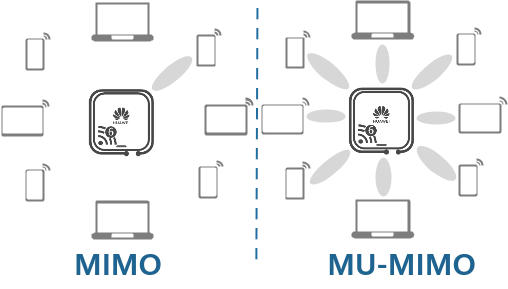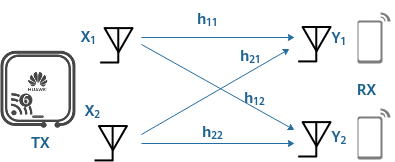What Is MU-MIMO?
Multi-user multiple-input multiple-output (MU-MIMO) is a multi-user technology that plays an important role in the wireless communications field. This technology allows one AP to communicate with multiple terminals simultaneously, fully utilizing space resources and improving wireless throughput. MU-MIMO is mainly applicable to cellular networks and Wi-Fi (also known as WiFi) networks.
MU-MIMO vs. MIMO
Before we can delve into MU-MIMO, we must first understand how MIMO works. Simply put, MIMO technology divides network resources spatially, which are transmitted simultaneously through multiple antennas.

MIMO system
MIMO technology greatly improves the data transmission efficiency of a single device without occupying extra spectrum resources. MIMO has greatly contributed to the surge of Wi-Fi transmission rates — for example, evolving from 54 Mbit/s (802.11g) to 300 Mbit/s or even 600 Mbit/s (802.11n).
In a MIMO system, an AP can communicate with only one terminal at a time. This is why MIMO is sometimes also known as single-user MIMO (SU-MIMO). When the number of antennas on a terminal is the same as that on an AP, space resources of the AP can be fully effective. Practically speaking, we cannot require the APs and terminals on a Wi-Fi network to have the same number of antennas. This is because APs typically have three or four antennas, whereas most terminals (such as mobile phones) have only one or two. As a result, the APs and terminals are unable to make the most of channel resources. Case in point is a Wi-Fi 5 AP that supports 4x4 (4T4R) MIMO can provide a maximum theoretical speed of 1.732 Gbit/s. When it communicates with a mobile phone (1x1 MIMO), the maximum theoretical speed can reach only 433 Mbit/s, one quarter of the AP's speed peak. Three antennas stay idle during communication, meaning a speed of 1.3 Gbit/s is unused.
To address this issue, MU-MIMO technology is introduced. It enables an AP to communicate with multiple terminals simultaneously, thereby fully utilizing the AP capacity.

MU-MIMO vs. MIMO
Compared with SU-MIMO, MU-MIMO better utilizes space resources and significantly improves throughput.
MIMO typically uses MxN, where M indicates the number of Tx antennas and N indicates the number of Rx antennas. MU-MIMO implements multi-user communication by adding the indicator of MU based on MIMO, and is represented by MxN:U. MxN still indicates the number of MIMO antennas, and U indicates the number of MUs, that is, the number of terminals that can communicate simultaneously with the peer end. For example, in the MU-MIMO specification 8x8:8, 8 after the colon indicates that a maximum of eight terminals can communicate simultaneously with the peer end.
What Are the Benefits of MU-MIMO?
MU-MIMO can have a positive impact on wireless networks in scenarios where users are densely distributed, a large amount of concurrent traffic occurs for multiple users, and terminals are relatively fixed at specific locations, for example, offices, conference centers, and electronic classrooms (e-classrooms).
Increases network throughput and spectrum utilization.
MU-MIMO can improve the throughput of a wireless network by two to three times compared with a wireless network using SU-MIMO. MU-MIMO enables more antennas on an AP to play their roles, thereby providing more space resources and delivering higher throughput.
Meets requirements of bandwidth-hungry applications such as video services.
MU-MIMO allows multiple terminals to transmit data concurrently, which improves data transmission efficiency on a wireless network while reducing the waiting time of terminals in terms of time sequence. Therefore, MU-MIMO can better meet the requirements of video, audio, and other applications that require high bandwidth and low latency.
Benefits legacy Wi-Fi terminals.
The overall efficiency improvement brought by MU-MIMO enables more idle time or capacity on the network to serve legacy Wi-Fi terminals (that support only SU-MIMO). This improves the application experience for legacy Wi-Fi terminals.
How Does MU-MIMO Work?
MU-MIMO works with beamforming technology to implement simultaneous communication with multiple terminals. An AP measures the characteristics of channels from each antenna to each terminal. Then, based on the channel characteristics, the AP performs precoding calculation on the data to be transmitted, and transmits the precoded signals on each antenna. In this manner, when data from all antennas reaches terminals, each terminal receives only data destined for themselves. This is similar to forming directional beams to each terminal.
The following uses a 2x2 MU-MIMO model as an example to illustrate the overall working process of MU-MIMO. The actual calculation and processing may be more complex.

MU-MIMO implementation
Antennas on the transmit end send data X1 and X2, which, after attenuation and interference during transmission, change to Y1 and Y2 when arriving at the receive end. Four transmission paths (h) in the space are coefficients of data changes and are used to represent radio channel characteristics. Therefore, data Y received by the receive end can be calculated as long as h is known.

MIMO signal calculation
If the receive end is only one terminal, this process is SU-MIMO. In this case, the transmit end needs to send only one piece of standard data X known to both itself and the receive end. Then, the receive end can calculate h based on the received Y and the known X. To enable the receive end to directly receive the specified raw data, substitute the raw data into Y, and the data X to be sent can be produced through reverse calculation based on the known h. This is a precoding process.
In MU-MIMO, there are multiple terminals on the receive end, and each of them knows only Y received by themselves. Consequently, h can be calculated only by the transmit end but not by the receive end. The transmit end needs to complete calculation of h by means of channel sounding. Specifically, the transmit end sends data X to each terminal. After receiving X, terminals reply with Y to the transmit end. With the known X and Y values, the transmit end calculates h. Then, based on h, the transmit end precodes data for transmission to multiple terminals at a time.
Channel characteristics of the wireless space keep changing. Therefore, h needs to be calculated each time before data is sent. The interval between calculation and data transmission is extremely short, so the impact of a channel change on transmitting and receiving data can be ignored.
MU-MIMO can be classified into downlink MU-MIMO (DL MU-MIMO) and uplink MU-MIMO (UL MU-MIMO) based on the transmission direction. DL MU-MIMO enables an AP to send data to multiple terminals simultaneously, while UL MU-MIMO allows an AP to receive data from multiple terminals simultaneously.
Which Wi-Fi Devices Support MU-MIMO?
During the 802.11 standard evolution, 802.11ac Wave 2 (Wi-Fi 5) introduced MU-MIMO technology, specifically, DL MU-MIMO, allowing an AP to send data to a maximum of four terminals simultaneously. After 802.11ax (Wi-Fi 6) introduced UL MU-MIMO technology, the bottleneck of uplink multi-user transmission was addressed. Additionally, an AP can communicate with a maximum of eight terminals simultaneously in 802.11ax, further improving transmission efficiency in densely populated scenarios. Therefore, Wi-Fi 5 devices support DL MU-MIMO, and Wi-Fi 6 devices support DL and UL MU-MIMO.
To make MU-MIMO effective, the APs and terminals both need to support MU-MIMO. If terminals do not support MU-MIMO, APs communicate with them using SU-MIMO. For terminals that support MU-MIMO, APs communicate with them using MU-MIMO.
For MU-MIMO capabilities of Huawei products, see AirEngine Wi-Fi 6 products.
- Author: Wang Yibo
- Updated on: 2022-04-02
- Views: 34137
- Average rating:








